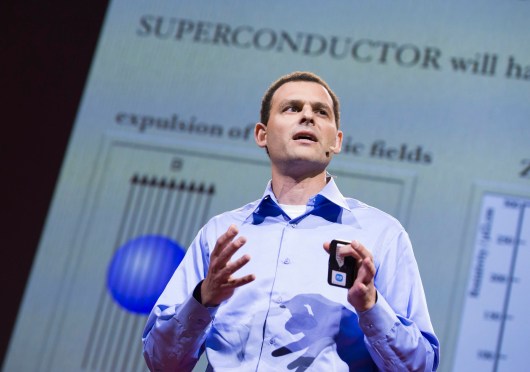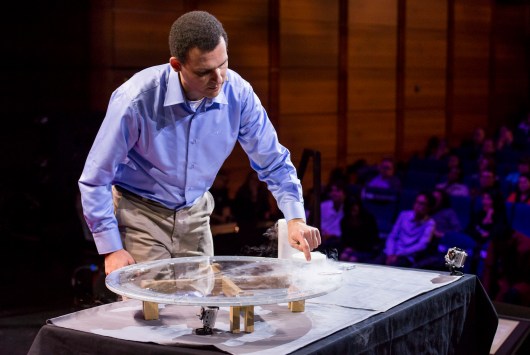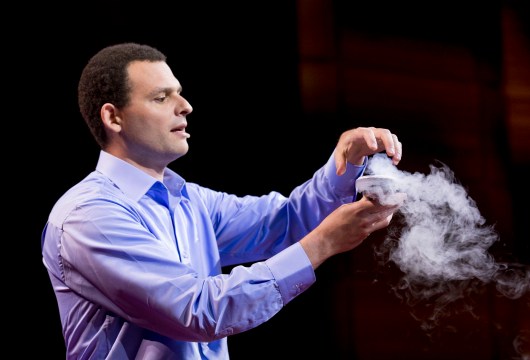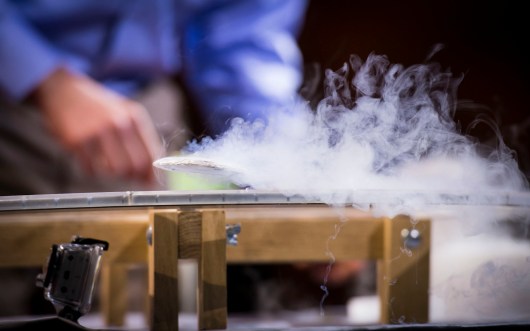After rescuing his equipment from UK customs, where it had been stuck for several days, Boaz Almog take the stage to demonstrate his remarkable research.
It uses a well-known phenomenon of superconductivity — a state of matter where the electrical resistance drops to zero. Normally, electrons moving through a conductor collide occasionally, losing energy to heat — that is resistance. But in a superconductor, there are no collisions, none at all (this is one of the strange effects of quantum mechanics), and hence no resistance. Additionally, the superconductor expels all magnetic fields, another defining characteristic.
But sometimes strands of magnetic field can get stuck inside a superconductor. In that case, they are quantized: they come in discrete units that behave like particles. He calls them fluxons, because they’re particles of magnetic flux.
Now, if you put the superconductor inside a magnetic field, the material doesn’t like the fluxons to move, because that would create resistance, so the object will “lock” the magnetic fields in place. So Almog can use that to create what he calls “quantum locking.”
He does just that, spectacularly, by taking a supercooled superconductor out of a container of liquid notrogen and holding it above a magnet, seemingly magically locking it into position.
How many strands in a disk, you might ask? 100 billion in a 3-inch disk, it turns out. But that’s not the end of the story. The actual part of the disk that’s a superconductor is only a half a micron thick, but it can levitate the entire disk — 70,000 times its own weight.
Almog then takes the disk and puts it on a circular track. Amazingly, the disk appears locked in place while it races around the track, even if the track is turned upside down.
In writing, this sounds a bit like an ordinary magnet. It’s not. When you see the disk in action, it’s obvious that something more is going on. Normal magnets wiggle, and this one sits there, completely locked in place. To get a sense of that, watch a demonstration of the quantum locking disk >>
What can quantum locking be used for? Hm. Currently we use superconductors for magnets in MRI machines or for storing energy. We’re just beginning to see what quantum locking could be used for, Almog says, but he can easily imagine a tiny wafer that could hold the weight of an entire car.
What does this look like? Have a look:
Photos: James Duncan Davidson







Comments (12)
Pingback: Dream Big as Small Biz People - Entrepreneur News | Australian Society of Entrepreneurs
Pingback: Quantum Locking | Nutcracker
Pingback: Quantum levitation in action: Raw footage from Boaz Almog’s TEDGlobal talk « Content Curated By Darin R. McClure & a few photos
Pingback: Quantum levitation in action: Raw footage from Boaz Almog’s TEDGlobal talk - Entrepreneur News | The Australian Society of Entrepreneurs
Pingback: Quantum levitation in action: Raw footage from Boaz Almog’s TEDGlobal talk | Indoor Digital Billboards
Pingback: Quantum levitation in action: Raw footage from Boaz Almog’s TEDGlobal talk | Krantenkoppen Tech